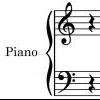Lately, there has been a proliferation of tutorials and videos on you tube about "negative harmony" or "mirror harmony", most of them say nothing.
Because..., yes, it's easy to understand the concept, but how the hell to use it?
Given a melody and harmony we can obtain their mirror versions... What can we do with them? I haven't found anything about it.
I have some experience developing harmonic and melodic systems from any given scale, and I wanted to try with an example. I'm not going to explain anything about this kind of harmonies, only saying it is based on mirrored notes (that can build melody or chords) using an tonic-dominant axis (not mirroring everything from a single -tonic-note; that's other type of harmony).
So let's begin:
01 - I wrote a simple thing in A major with a melody and a counter melody, the raw material called 01. A track with strings as background and a bass line.
02 - In this version, the first part is the same than in 01, but the second part (page) is the negative version changing melodies, chords and bass line. Interesting! This could be use as the repetition of a phrase or section...
03 - In this case, there is some blending. In the first part the guitar an the strings are in "positive" A maj, and the flute and the bass in "negative". In the second part the guitar and strings are in"negative" and the flute and the bass in "positive".
04 - A step further... An additional track for strings is added and the harmony plays "positive" and "negative" all the piece long. This creates a cluster effect. In the first part (m. 1-16) guitar in positive, flute and bass in negative. In the second part (m. 17-32) guitar in negative and flute and bass in positive.
There are many more possible combinations. The more harmonies are mixed, the "opener" our ears should be. I think it's also possible to make this mix and change some clashing chords here and there, depending on the desired effect.
I like the results and I think there is a lot of potential here. Surely many people won't like it...
I hope you enjoy it. It's just an exercise, not a composition.
01 - Score.pdf
02 - Score.pdf
03 - Score.pdf
04- Score.pdf




.thumb.png.8b5b433a341551e913a34392660bc95b.png)